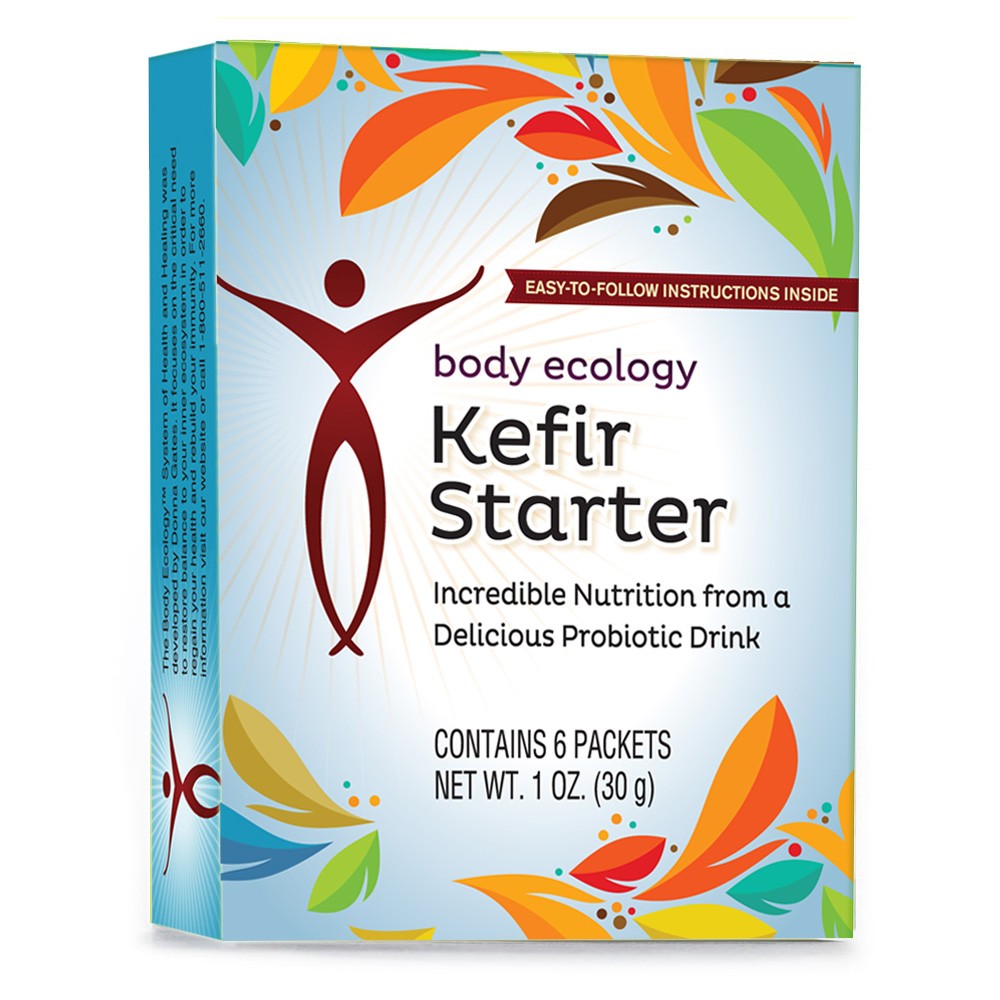What is Kefir?
Kefir is a cultured, enzyme-rich food filled with friendly micro-organisms that help balance your “inner ecosystem.” More nutritious and therapeutic than yogurt, it supplies complete protein, essential minerals, and valuable B vitamins.
- Kefir is simple and inexpensive to make at home.
- Kefir is used to restore the inner eco-system after antibiotic therapy.
- Kefir can be made into a delicious smoothie that kids love.
- Kefir is excellent nourishment for pregnant and nursing women, the elderly, and those with compromised immunity.
 Kefir is the perfect probiotic superfood for everyone! And we’ve made it easy for you to make it at home with the Kefir Starter.
Kefir is the perfect probiotic superfood for everyone! And we’ve made it easy for you to make it at home with the Kefir Starter.Kefir is a cultured, creamy product with amazing health attributes.
Kefir’s tart and refreshing flavor is similar to a drinking-style yogurt, but it contains beneficial yeast as well as friendly ‘probiotic’ bacteria found in yogurt. The naturally occurring bacteria and yeast in kefir combine symbiotically to give superior health benefits when consumed regularly. It is loaded with valuable vitamins and minerals and contains easily digestible complete proteins.
What if I’m lactose intolerant, and don’t do dairy? Or don’t digest milk products well? Is kefir right for me?
For the lactose intolerant, kefir’s abundance of beneficial yeast and bacteria provide lactase, an enzyme which consumes most of the lactose (or milk sugar) left after the culturing process. Eat kefir on an empty stomach first thing in the morning before (or for) breakfast and you’ll be delighted to find it can be easily digested — as numerous people who have been lactose intolerant for years have discovered.
How is Kefir Made?
Kefir can be made from any type of milk, cow, goat or sheep, coconut, rice or soy. Although it is slightly mucous forming, the mucous has a “clean” quality to it that creates ideal conditions in the digestive tract for the colonization of friendly bacteria.
Kefir is made from gelatinous white or yellow particles called “grains.” This makes kefir unique, as no other milk culture forms grains. These grains contain the bacteria/yeast mixture clumped together with casein (milk proteins) and complex sugars. They look like pieces of coral or small clumps of cauliflower and range from the size of a grain of wheat to that of a hazelnut. Some of the grains have been known to grow in large flat sheets that can be big enough to cover your hand!. The grains ferment the milk, incorporating their friendly organisms to create the cultured product. The grains are then removed with a strainer before consumption of the kefir and added to a new batch of milk.
Why Kefir is Better than Yogurt
Kefir contains several major strains of friendly bacteria not commonly found in yogurt, Lactobacillus Caucasus, Leuconostoc, Acetobacter species, and Streptococcus species.
It also contains beneficial yeasts, such as Saccharomyces kefir and Torula kefir, which dominate, control and eliminate destructive pathogenic yeasts in the body. They do so by penetrating the mucosal lining where unhealthy yeast and bacteria reside, forming a virtual SWAT team that housecleans and strengthens the intestines. Hence, the body becomes more efficient in resisting such pathogens as E. coli and intestinal parasites.
Kefir’s active yeast and bacteria provide more nutritive value than yogurt by helping digest the foods that you eat and by keeping the colon environment clean and healthy. Because the curd size of kefir is smaller than yogurt, it is also easier to digest, which makes it a particularly excellent, nutritious food for babies, the elderly and people experiencing chronic fatigue and digestive disorders.
Body Ecology Kefir Starter contains the following beneficial bacteria:
- Lactococcus lactis subsp. lactis
- Lactococcus lactis subsp. cremoris
- Lactococcus lactis subsp. diacetylactis
- Leuconostoc mesenteroides subsp. cremoris
- Lactobacillus plantarum
- Lactobacillus casei
- Saccharomyces boulardii
- Kluyveromyces Marxianus
- Inulin
Contains 6 packets which can be used an average of 7 times each. 1/4 cup of previous batch will ferment 1 quart of liquid. 1 cup will make one gallon, and so on. For prolonged shelf life, keep refrigerated before using.
Kefir Benefits
Easily digested, it cleanses the intestines, provides beneficial bacteria and yeast, vitamins and minerals, and complete proteins. Because kefir is such a balanced and nourishing food, it contributes to a healthy immune system and has been used to help patients suffering from AIDS, chronic fatigue syndrome, herpes, and cancer. Its tranquilizing effect on the nervous system has benefited many who suffer from sleep disorders, depression, and ADHD (attention deficit hyperactivity disorder).
The regular use of kefir can help relieve all intestinal disorders, promote bowel movement, reduce flatulence and create a healthier digestive system. In addition, its cleansing effect on the whole body helps to establish a balanced inner ecosystem for optimum health and longevity.
Kefir can also help eliminate unhealthy food cravings by making the body more nourished and balanced. Its excellent nutritional content offers healing and health-maintenance benefits to people in every type of condition.
How to Introduce Kefir Into Your Diet
Some people thrive on kefir right from the start and others may need to proceed more slowly. Remember that people with candidiasis lack milk-digesting bacteria, so you may have to build up your “tolerance” of kefir. Start with about four ounces in the morning on an empty stomach. Every second day increase the amount until you are able to drink a full eight ounce glass.
If you are just beginning the therapeutic version of the Body Ecology Diet’s health recovery program, it might be best to wait three to six months before introducing kefir. You may first need to clear your body of accumulated toxins and see your symptoms disappear. Moreover, people with candidiasis have what Chinese medicine calls the condition of dampness. Unfermented and improperly combined dairy products can lead to even more dampness and excess mucus. Here are some suggestions for introducing kefir while conquering dampness.
- Eat Body Ecology Diet foods, which are drying.
- Use proper food combining techniques to make kefir less mucus-forming (see the Body Ecology Diet 7th Edition).
- Drink plenty of water and eat grains that have been soaked and then cooked. These add moisture and fiber to the colon.
- Clean your colon. If a colon is free of blockages, kefir is tolerated more quickly. We have found that people who report having trouble with kefir, often have not followed the advice on colon cleansing. You probably also need to add acidophilus and bifidus bacteria to your small and large intestines. These wonderful bacteria also help to clean and improve the health of your entire digestive tract.
- Be sure to get adequate exercise. Exercise stimulates the colon and improves elimination.
Kefir Recipes
Refreshing Kefir Drink
Make kefir with the freshest milk possible and add as many of the following ingredients as desired:
- 1 tsp. of unrefined flax seed oil
- Lecithin, which aids fat digestion, to taste
- Fiber, such as Nutri-Flax
- Probiotics (friendly bacteria)
- Natural flavorings or herbs such as stevia, nutmeg, cinnamon, non-alcoholic vanilla or natural fruit flavoring
- Fresh or frozen organic fruits, strawberries, raspberries, bananas, kiwi, mango etc.
Blend together for a delicious, nutritious breakfast, lunch, or snack and enjoy!
Cool Kefir Dressing (no oil)
- 2 cups fresh Kefir
- 1 heaping tbs. fresh parsley, chopped
- 1 heaping tbs. fresh chives, minced
- 1 heaping tbs. fresh lemon zest, finely chopped
- 1 heaping tbs. fresh garlic, finely chopped
- 1 tsp. sea salt
- 1/4 tsp. Herbamare™
- 1/2 tsp. xanthan gum
- Combine all ingredients (except xanthan gum) and blend thoroughly.
- Slowly add xanthan gum and continue to blend until mixture thickens.
- Full flavor will develop after 6 to 8 hours.
Note: Dairy products combine best with non-starchy vegetables and acid fruits. Don’t hesitate to add a little Flax Seed Oil to this recipe.








